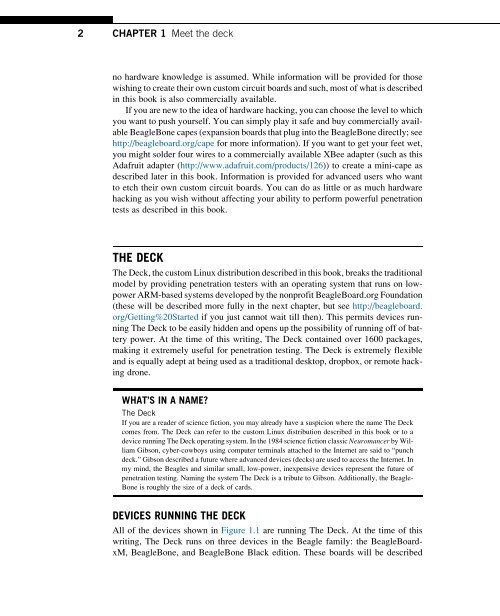Hacking_and_Penetration_Testing_with_Low_Power_Devices
You also want an ePaper? Increase the reach of your titles
YUMPU automatically turns print PDFs into web optimized ePapers that Google loves.
2 CHAPTER 1 Meet the deck<br />
no hardware knowledge is assumed. While information will be provided for those<br />
wishing to create their own custom circuit boards <strong>and</strong> such, most of what is described<br />
in this book is also commercially available.<br />
If you are new to the idea of hardware hacking, you can choose the level to which<br />
you want to push yourself. You can simply play it safe <strong>and</strong> buy commercially available<br />
BeagleBone capes (expansion boards that plug into the BeagleBone directly; see<br />
http://beagleboard.org/cape for more information). If you want to get your feet wet,<br />
you might solder four wires to a commercially available XBee adapter (such as this<br />
Adafruit adapter (http://www.adafruit.com/products/126)) to create a mini-cape as<br />
described later in this book. Information is provided for advanced users who want<br />
to etch their own custom circuit boards. You can do as little or as much hardware<br />
hacking as you wish <strong>with</strong>out affecting your ability to perform powerful penetration<br />
tests as described in this book.<br />
THE DECK<br />
The Deck, the custom Linux distribution described in this book, breaks the traditional<br />
model by providing penetration testers <strong>with</strong> an operating system that runs on lowpower<br />
ARM-based systems developed by the nonprofit BeagleBoard.org Foundation<br />
(these will be described more fully in the next chapter, but see http://beagleboard.<br />
org/Getting%20Started if you just cannot wait till then). This permits devices running<br />
The Deck to be easily hidden <strong>and</strong> opens up the possibility of running off of battery<br />
power. At the time of this writing, The Deck contained over 1600 packages,<br />
making it extremely useful for penetration testing. The Deck is extremely flexible<br />
<strong>and</strong> is equally adept at being used as a traditional desktop, dropbox, or remote hacking<br />
drone.<br />
WHAT’S IN A NAME?<br />
The Deck<br />
If you are a reader of science fiction, you may already have a suspicion where the name The Deck<br />
comes from. The Deck can refer to the custom Linux distribution described in this book or to a<br />
device running The Deck operating system. In the 1984 science fiction classic Neuromancer by William<br />
Gibson, cyber-cowboys using computer terminals attached to the Internet are said to “punch<br />
deck.” Gibson described a future where advanced devices (decks) are used to access the Internet. In<br />
my mind, the Beagles <strong>and</strong> similar small, low-power, inexpensive devices represent the future of<br />
penetration testing. Naming the system The Deck is a tribute to Gibson. Additionally, the Beagle-<br />
Bone is roughly the size of a deck of cards.<br />
DEVICES RUNNING THE DECK<br />
All of the devices shown in Figure 1.1 are running The Deck. At the time of this<br />
writing, The Deck runs on three devices in the Beagle family: the BeagleBoardxM,<br />
BeagleBone, <strong>and</strong> BeagleBone Black edition. These boards will be described


